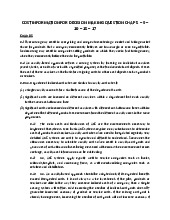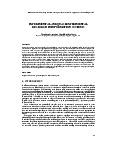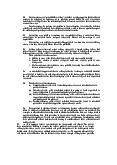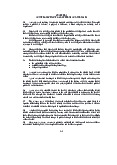





Preview text:
CONSUME RBEHVAIOUR OVERVIEW & DECISION MAKING
1. Any individual who purchases goods and services from the market for
his/her end-use is called a.................. A. customer B. purchaser C. consumer D. all these
2. ------------ is nothing but willingness of consumers to purchase products
and services as per their taste, need and of course pocket. A. consumer behaviour B. consumer interest C. consumer attitude D. consumer perception
3. ------------- is a branch which deals with the various stages a consumer goes
through before purchasing products or services for his end use. A. consumer behaviour B. consumer interest C. consumer attitude D. consumer perception
4. -------------- refers to how an individual perceives a particular message A. consumer behaviour B. consumer interest C. consumer attitude D. consumer interpretation
5. “----------- is the action and decisions process or people who purchase
goods and services for personal consumption.” A. consumer behaviour B. consumer interest C. consumer attitude D. consumer interpretation
6. ________________ emphasize(s) that profitable marketing begins with the
discovery and understanding of consumer needs and then develops a
marketing mix to satisfy these needs. A. the marketing concept B. the strategic plan C. the product influences D. the price influences
7. ________________ is one of the most basic influences on an individual’s needs, wants, and behaviour. A. brand B. culture C. product D. price
8. In terms of consumer behaviour; culture, social class, and reference
group influences have been related to purchase and _______________. A. economic situations B. situational influences C. consumption decisions D. physiological influences
9. Many sub-cultural barriers are decreasing because of mass
communication, mass transit, and a ___________________.
A. decline in the influence of religious values
B. decline in communal influences
C. strong awareness of brands in the market
D. strong awareness of pricing policies in the market
10. ___________ develop on the basis of wealth, skills and power. A. economical classes B. purchasing communities C. competitors D. social classes
11. _____________ (is) are transmitted through three basic organizations: the
family, religious organizations, and educational institutions; and in today’s
society, educational institutions are playing an increasingly greater role in this regard. A. consumer feedback
B. marketing information systems C. market share estimates D. cultural values
12. In large nations, the population is bound to lose a lot of its homogeneity,
and thus _________________ arise. A. multilingual needs B. cultures C. subcultures
D. product adaptation requirements
13. _______________ are based on such things as geographic areas, religions,
nationalities, ethnic groups, and age. A. multilingual needs B. cultures C. subcultures
D. product adaptation requirements
14. Marketing managers should adapt the marketing mix to
___________________ and constantly monitor value changes and differences in
both domestic and global markets. A. sales strategies B. marketing concepts C. cultural values D. brand images
15. _____________ has become increasingly important for developing a
marketing strategy in recent years.
A. change in consumers’ attitudes B. inflation of the dollar C. the concept and the brand
D. age groups, such as the teen market, baby boomers, and the mature market
16. Two of the most important psychological factors that impact consumer
decision-making process are product _____________ and product involvement. A. marketing B. strategy C. price D. knowledge
17. Which of the following is the most valuable piece of information for
determining the social class of your best friend's parents?
A. the number of years schooling that they had B. their ethnic backgrounds
C. their combined annual income D. their occupations
18. Changes in consumer values have been recognized by many business
firms that have expanded their emphasis on ____________ products. A. latest technology
B. timesaving, convenience-oriented C. health related D. communication
19. Many sub cultural barriers are decreasing because of mass
communication, mass transit, and ________________.
A. the rising unemployment situation
B. an influence of political power C. the use of new technology
D. a decline in the influence of religious values
20. Different social classes tend to have different attitudinal configurations
and _______ that influence the behaviour of individual members. A. personalities B. values C. finances D. decision makers
21. In terms of consumption decisions, middle class consumers prefer to _________.
A. buy at a market that sells at a whole sale rates B. buy what is popular
C. buy only the brands which sell at affordable prices
D. analyze the market and select the best at the lowest prices
22. _________________ refers to the buying behavior of final consumers. A. consumer buyer behavior . B. target market buying C. market segment buying D. business buying behavior
23. ____________ is individuals and households who buy goods and services for personal consumption. A. the target market B. a market segment C. the consumer market . D. the ethnographic market
24. Understanding consumer buying behavior is not easy. The answers are
often locked deep within the consumer’s head. The central question for marketers is:
A. how much money is the consumer willing to spend?
B. how much does the consumer need the product being offered for sale?
C. how much does a discount or a coupon affect the purchase rate?
D. how do consumers respond to various marketing efforts the company might use? .
25. The starting point in understanding how consumers respond to various
marketing efforts the company might use is the:
A. lipinski model of buying behavior.
B. stimulus-response model of buyer behavior. .
C. freudian model of buying behavior.
D. maslow’s model of life-cycle changes.
26. According to the stimulus-response model of buyer behavior, the place
where consumers process marketing stimuli prior to making purchase decision is called the: A. consumer’s value chain.
B. consumer’s cognitive schema. C. consumer’s black box. .
D. consumer’s thoughts-emotions network.
27. Consumer purchases are influenced strongly by cultural, social, personal, and:
A. psychographic characteristics.
B. psychological characteristics. .
C. psychometric characteristics.
D. supply and demand characteristics.
28. ______________ is the most basic cause of a person’s wants and behaviors. A. culture . B. social class C. personality D. lifestyle
29. Marketers are always trying to spot _____ in order to discover new
products that might be wanted. A. opinion graphers B. dissonant groups C. cultural shifts . D. benchmarks
30. The cultural shift toward _____________ has resulted in more demand for
casual clothing and simpler home furnishings. A. liberal political causes
B. conservative political causes C. informality . D. downsizing



